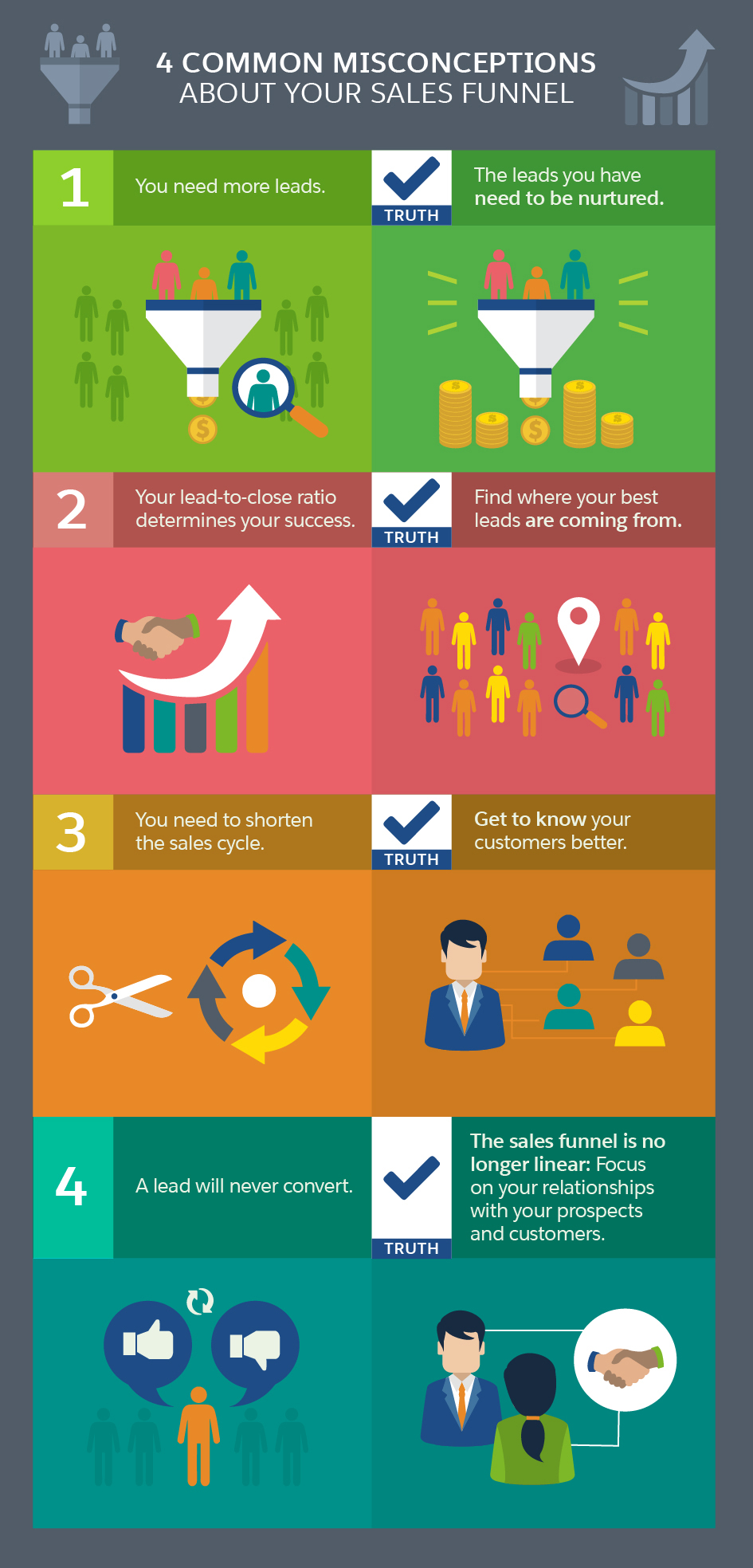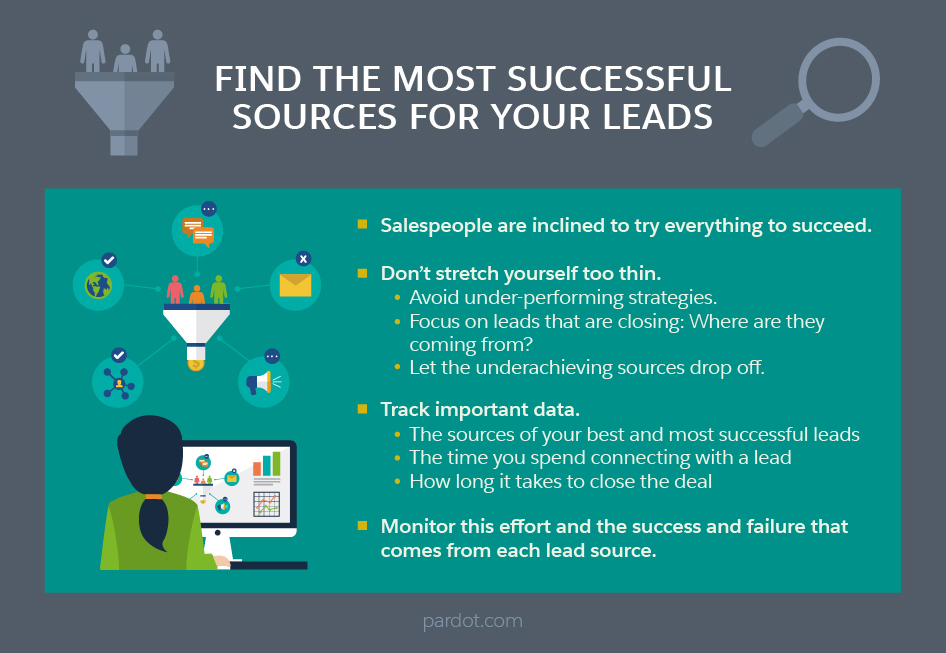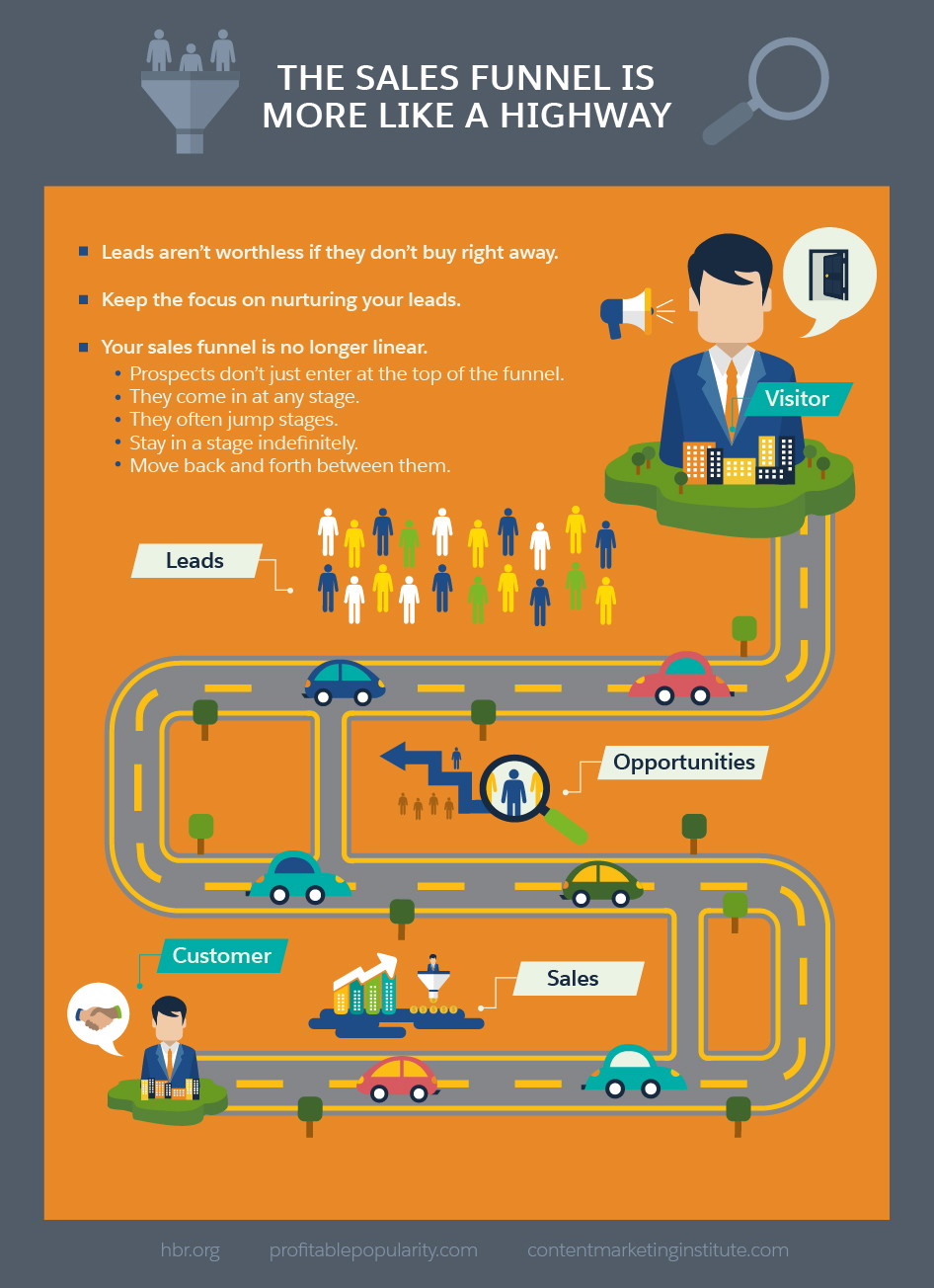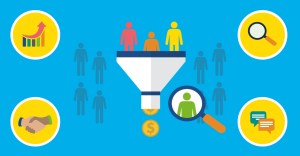At a quick glance, it’s easy to make superficial assumptions about the effectiveness of your sales funnel. Without further analysis, the initial conclusions you draw from the data may be misleading because a broad overview of your sales performance is not a true indicator of sales potential. Once you audit your sales behaviors and dissect the data, you may discover smart ways to improve your overall results.
In this article, we outline four common misconceptions salespeople have about sales funnel management and optimization alongside clever solutions for each.

4 Common Misconceptions about Your Sales Funnel
- 1. You need more leads
- Truth: The leads you have need to be nurtured
- 2. Your lead-to-close ratio determines your success
- Truth: Find where your best leads are coming from
- 3. You need to shorten the sales cycle
- Truth: Get to know your customers better
- 4. A lead will never convert
- Truth: The sales funnel is no longer linear: Focus on your relationships with your prospects and customers

Misconception #1: I need more leads
In sales, there is a belief that more is better. Simple math suggests that doubling your leads will double your sales. Theoretically, yes. Of course, doing so is a resource-intensive exercise. For sales teams to extract more value out of their existing assets and initiatives, they need to work smarter, not harder.
At the top of your sales funnel, you may notice that many inbound leads do not progress beyond the first or second stages of the sales process. Sales expert Ken Krogue insists that this is because an alarming number of sales leads are often ignored. Thus, sales teams do not necessarily need more sales leads; instead, they should make a more conscious effort to engage existing leads. For Forbes, he writes, “Companies waste 71 per cent of Internet leads.”
The failure here is sales teams do not respond to leads fast enough, if at all. Krogue notes, “In fact, they take 46 hours and 53 minutes to pick up the phone and respond to a lead. And the sales rep who does call only makes 1.3 call attempts before giving up and moving on.” He adds, “Our own in-house research shows only 27 per cent of leads ever get contacted. Yet with a combination of awareness, best practices, and technology, companies can contact around 92 per cent of leads. An increase from 27 per cent to 92 per cent is an increase of 341 per cent lift in results just by responding immediately and persistently to leads.”
Salespeople should be quick to connect with new leads. Research shows that “firms that tried to contact potential customers within an hour of receiving a query were nearly seven times as likely to qualify the lead (which we defined as having a meaningful conversation with a key decision maker) as those that tried to contact the customer even an hour later—and more than 60 times as likely as companies that waited 24 hours or longer.” To close the gap between the number of leads generated and deals closed, salespeople should aim to respond to new leads as soon as they come in.
Misconception #2: My overall lead-to-close ratio determines my success
Your overall lead-to-close ratio may be deceiving. Although you may improve your sales performance with each change you make to your sales process—such as shortening your average lead response time—a more strategic approach to sales funnel optimization includes segmenting your funnel by lead source.
The 2014 B2B Sales Benchmarks report found that among B2B businesses, customers and employees referred the highest quality leads. The report’s analysis states that customer and employee referrals had a 3.63 per cent lead-to-deal conversion rate. By comparison, website leads had a 1.55 per cent lead-to-deal conversion rate. Social media leads were only 1.47 per cent likely to convert to sales. Paid search leads, sales-generated leads, and marketing leads each had less than a one per cent conversion rate.
Clearly, customers from different channels respond differently to your offer. So, to better understand how well your own sales funnel performs with leads from unique sources, Yaniv Masjedi suggests, “Take a minute to write down your sources for sales leads. Maybe you run regular Google ad campaigns, Twitter ad campaigns, and email marketing initiatives, or attend in-person networking events. Once you have your list, zero in on each strategy and how it is producing for you.”
Masjedi illustrates his point with two examples:
- “Let’s say you receive 100 leads from one source. You connect with 30 of those leads and 40 per cent of them convert. For many companies, those numbers would prove the source exceptionally valuable.”
- “Conversely, another source produces 75 leads and only five of them end up closing. That means that you and your team spent time with dead 70 leads. The return on your time investment doesn’t add up to the first example in this case.”
Then, he explains, “In order to be productive in sales, it is vital to track the sources of your best and most successful leads. Understand the time you spend connecting with a lead and eventually closing the deal. Track this effort and the success and failure that comes from each lead source.” This more targeted approach to sales funnel management and optimization may allow you to more strategically allocate your time and effort.
By segmenting your funnel by lead source, you identify which channels drive prospects that are most likely to convert into a sale.
Find the Most Successful Sources for Your Leads
- Salespeople are inclined to try everything to succeed
- Don’t stretch yourself too thin
- Avoid under-performing strategies
- Focus on leads that are closing—where are they coming from?
- Let the underachieving sources drop off
- Track important data
- The sources of your best and most successful leads
- The time you spend connecting with a lead
- How long it takes to close the deal
- Monitor this effort and the success and failure that comes from each lead source

Misconception #3: I need to shorten the sales cycle
As more sales automation tools crop up, sales teams everywhere are eager to shorten their sales cycle. Believing that automation can expedite stages and steps in the sales process, many sales reps seek to spend less time interacting with prospects. They also assume that with less effort they may even secure more sales.
Counterintuitively, elongating the sales cycle may actually improve your sales performance. For true, consultative selling, salespeople may want to spend more time hand-holding potential clients through the decision making process. While sales automation software helps reduce repetitive, time-consuming tasks, it should primarily allow salespeople to focus on what’s most important: time spent with clients.
With extra lead nurturing and education, prospects may be more likely to convert into customers. In fact, data from MarketingSherpa asserts “79 per cent of marketing leads never convert into sales. Lack of lead nurturing is the common cause of this poor performance.” By intentionally pursuing a longer sales cycle, you may:
- Discover more of your client’s explicit and latent needs
- Carefully address any objections they may have at each stage of the sales process
- Build credibility and establish yourself as a thought leader that customers will want to work with
- Extend value to potential customers to develop loyalty and trust
- Generate buy-in with other decision makers within a potential customer’s organization
- Wait for the right moment when a lead is ready to commit to a purchase
- Sell your prospect higher priced products and solutions, increasing average deal size
Misconception #4: These leads will never convert
When salespeople look at their funnel, they may see a number of prospects stuck at a specific stage. After a certain number of days, emails, or phone conversations, sales reps may categorize those leads as dead. Here, sales teams make the mistake of assuming those leads will never convert—and they would be wrong.
The Sales Funnel is More Like a Highway
- Leads aren’t worthless if they don’t buy right away
- Keep the focus on nurturing your leads
- Your sales funnel is no longer linear
- Prospects don’t just enter at the top of the funnel
- They come in at any stage
- They often jump stages
- Stay in a stage indefinitely
- Move back and forth between them

Dr. Rachna Jain, a business strategist and psychologist, believes a major sales funnel mistake is “assuming leads are worthless if they don’t buy right away.” She elaborates, “If someone doesn’t buy your $47 product today, that doesn’t mean they won’t buy your $2,500 workshop a year from now. Leads don’t always convert linearly … We all have stories of people who have been on our [sales] list for years and never purchase, and stories of people who heard of us once and invested in our highest level program. So keep the focus on nurturing your leads, even when they don’t buy right away.”
Digital experts Mark Bonchek and Cara France agree. In an article for Harvard Business Review, they write, “Prospects don’t just enter at the top of the funnel; instead, they come in at any stage. Furthermore, they often jump stages, stay in a stage indefinitely, or move back and forth between them.”
Indeed, the modern day sales funnel is no longer linear. To adapt to changing times, salespeople should avoid abandoning relationships with leads who are not yet ready to make a purchase.
Over time, salespeople can expect that circumstances will change with these contacts. For example:
- A potential customer’s company may receive new funding from investors and your contact may finally have enough budget to purchase your solutions.
- Your prospect may receive a promotion, giving them the authority to make new purchasing decisions.
- A former lead may switch jobs, earning a new position that grants her the ability to retain your services.
- The client is no longer satisfied with their current vendor and is actively seeking a replacement solution.
Of course, since commissions are not issued on the basis of future sales potential, you will still want to spend a majority of your time engaging leads who may purchase your products or services immediately. At the same time, you will want to allocate some of your energy toward periodically connecting with former prospects and evaluating whether or not to loop them back into the sales process. Perhaps in three months you may connect with an old lead who is ready to close a deal.

Share “Why You May Be Looking at Your Sales Funnel the Wrong Way” On Your Site

























